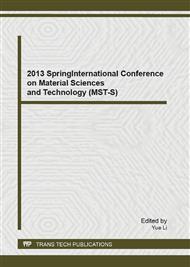[1]
M.R. Hoffmann, S.T. Martin, W. Choi and D.W. Bahnemann, Environmental applications of semiconductor photocatalysis, Chem Rev. 95(1995)69-96.
DOI: 10.1021/cr00033a004
Google Scholar
[2]
M.A. Fox and M.T. Dulay, Heterogeneous photocatalysis, Chem Rev. 93(1995)357.
Google Scholar
[3]
I.K. Konstantinou, T.M. Sakellarides, V.A. Sakkas and T.A. Albanis, Photocatalytic degradation of selected s-triazine herbicides and organophosphorus insecticides over aqueous TiO2 suspensions, Environ Sci Technol. 35(2001)389-396.
DOI: 10.1021/es001271c
Google Scholar
[4]
S. Parra, J. Olivero and C. Pulgarin, Relationships between physicochemical properties and photoreactivity of four biorecalcitrant phenylurea herbicides in aqueous TiO2 suspension, Appl Catal B. 36(2002)75-85.
DOI: 10.1016/s0926-3373(01)00283-1
Google Scholar
[5]
E. Vulliet, C. Emmelin, J.M. Chovelon, C. Guillard and J.M. Herrmann, Photocatalytic degradation of sulfonylurea herbicides in aqueous TiO2, Appl Catal B. 38(2002)127-137.
DOI: 10.1016/s0926-3373(02)00035-8
Google Scholar
[6]
Y. Cao, L. Yi, L. Huang, Y. Liu and Y.T. Lu, Mechanism and pathways of chlorfenapyr photocatalytic degradation in aqueous suspension of TiO2, Environ Sci Technol. 40(2006)3373-3379.
DOI: 10.1021/es052073u
Google Scholar
[7]
R. Ali and S.H. Hassan, Degradation studies on paraquat and malathion using TiO2/ZnO based photocatalyst, Malaysian J Anal Sci. 12(2008)77-86.
Google Scholar
[8]
K. Dai, T. Peng, H. Chen, R.X. Zhang and Y.X. Zhang, Photocatalytic degradation and mineralization of commercial methamidophos in aqueous titania suspension", Environ Sci Technol. 42(2008)1505-1511.
DOI: 10.1021/es702268p
Google Scholar
[9]
K. Dai, T. Peng, H. Chen, J. Liu and L. Zan, Photocatalytic degradation and mineralization of commercial methamidophos in aqueous titania suspension", Environ Sci Technol. 43(2009)1540-1545.
DOI: 10.1021/es802724q
Google Scholar
[10]
S.M. Gupta and M. Tripathi, A review of TiO2 nanoparticles, Chinese Science Bulletin. 56(16)(2011)1639-1645.
Google Scholar
[11]
S.L. Ding, Z.K. Li and R. Wang, Overview of dyeing wastewater treatment technology. Water resources protection 26(2010)73-78 (in Chinese)
Google Scholar
[12]
GB 11914-89. "Water quality-Determination of chemical oxygen demand-Dichromate method"(in Chinese)
Google Scholar
[13]
GB18918-2002. "Discharge Standards of Pollutants for Municipal Wasterwater Treatment Plant" (in Chinese)
Google Scholar
[14]
A. Fujishima, X.T. Zhang and D.A. Tryk, TiO2 photocatalysis and related surface phenomena, Surf. Sci. Reports, 63(2008)515-582.
DOI: 10.1016/j.surfrep.2008.10.001
Google Scholar
[15]
A.V. Emeline, V.K. Ryabchuk and N. Serpone, Dogmas and misconceptions in heterogeneous photocatalysis. Some enlightened reflections, J. Phys. Chem. B 109(2005)18515
DOI: 10.1021/jp0523367
Google Scholar
[16]
Q.L. Zhang, Z.J. Chen, Y. Zhu and H.Y. Xie, COD Removal of Washing Water by Photodegradation, Advanced Materials Research 549(2012)415-418.
DOI: 10.4028/www.scientific.net/amr.549.415
Google Scholar


